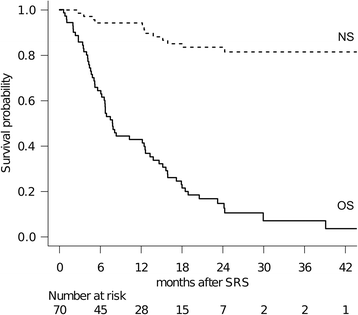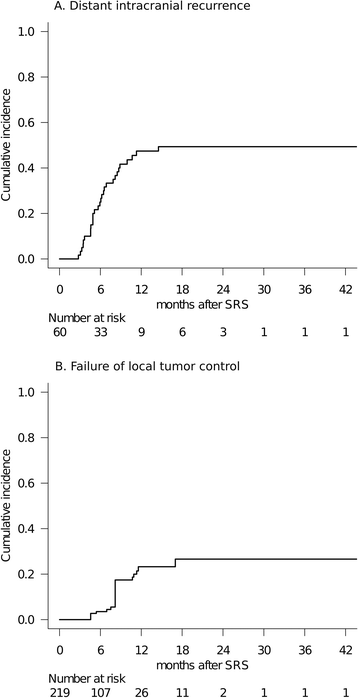Is stereotactic radiosurgery a rational treatment option for brain metastases from small cell lung cancer? A retrospective analysis of 70 consecutive patients
- PMID: 25879433
- PMCID: PMC4359776
- DOI: 10.1186/s12885-015-1103-6
Is stereotactic radiosurgery a rational treatment option for brain metastases from small cell lung cancer? A retrospective analysis of 70 consecutive patients
Abstract
Background: Because of the high likelihood of multiple brain metastases (BM) from small cell lung cancer (SCLC), the role of focal treatment using stereotactic radiosurgery (SRS) has yet to be determined. We aimed to evaluate the efficacy and limitations of upfront and salvage SRS for patients with BM from SCLC.
Methods: This was a retrospective and observational study analyzing 70 consecutive patients with BM from SCLC who received SRS. The median age was 68 years, and the median Karnofsky performance status (KPS) was 90. Forty-six (66%) and 24 (34%) patients underwent SRS as the upfront and salvage treatment after prophylactic or therapeutic whole brain radiotherapy (WBRT), respectively. Overall survival (OS), neurological death-free survival, remote and local tumor recurrence rates were analyzed.
Results: None of our patients were lost to follow-up and the median follow-up was 7.8 months. One-and 2-year OS rates were 43% and 15%, respectively. The median OS time was 7.8 months. One-and 2-year neurological death-free survival rates were 94% and 84%, respectively. In total, 219/292 tumors (75%) in 60 patients (86 %) with sufficient radiological follow-up data were evaluated. Six-and 12-month rates of remote BM relapse were 25% and 47%, respectively. Six-and 12-month rates of local control failure were 4% and 23%, respectively. Repeat SRS, salvage WBRT and microsurgery were subsequently required in 30, 8 and one patient, respectively. Symptomatic radiation injury, treated conservatively, developed in 3 patients.
Conclusions: The present study suggested SRS to be a potentially effective and minimally invasive treatment option for BM from SCLC either alone or after failed WBRT. Although repeat salvage treatment was needed in nearly half of patients to achieve control of distant BM, such continuation of radiotherapeutic management might contribute to reducing the rate of neurological death.
Figures


Similar articles
-
Is upfront stereotactic radiosurgery a rational treatment option for very elderly patients with brain metastases? A retrospective analysis of 106 consecutive patients age 80 years and older.BMC Cancer. 2016 Dec 15;16(1):948. doi: 10.1186/s12885-016-2983-9. BMC Cancer. 2016. PMID: 27978813 Free PMC article.
-
Upfront stereotactic radiosurgery in patients with brain metastases from small cell lung cancer: retrospective analysis of 41 patients.Radiat Oncol. 2014 Jul 8;9:152. doi: 10.1186/1748-717X-9-152. Radiat Oncol. 2014. PMID: 25005424 Free PMC article.
-
Prognostic factors for survival in patients treated with stereotactic radiosurgery for recurrent brain metastases after prior whole brain radiotherapy.Int J Radiat Oncol Biol Phys. 2012 May 1;83(1):303-9. doi: 10.1016/j.ijrobp.2011.06.1987. Epub 2011 Nov 11. Int J Radiat Oncol Biol Phys. 2012. PMID: 22079723
-
Should Stereotactic Radiosurgery Be Considered for Salvage of Intracranial Recurrence after Prophylactic Cranial Irradiation or Whole Brain Radiotherapy in Small Cell Lung Cancer? A Population-Based Analysis and Literature Review.J Med Imaging Radiat Sci. 2020 Mar;51(1):75-87.e2. doi: 10.1016/j.jmir.2019.10.001. Epub 2019 Nov 20. J Med Imaging Radiat Sci. 2020. PMID: 31759940 Review.
-
Repeated stereotactic radiosurgery for recurrent brain metastases: An effective strategy to control intracranial oligometastatic disease.Crit Rev Oncol Hematol. 2020 Sep;153:103028. doi: 10.1016/j.critrevonc.2020.103028. Epub 2020 Jun 20. Crit Rev Oncol Hematol. 2020. PMID: 32622322 Review.
Cited by
-
Validity test of small cell lung cancer (SCLC) graded prognostic assessment and proposal of a new index for patients with brain metastases from SCLC.Clin Transl Radiat Oncol. 2024 Jul 24;48:100820. doi: 10.1016/j.ctro.2024.100820. eCollection 2024 Sep. Clin Transl Radiat Oncol. 2024. PMID: 39156739 Free PMC article.
-
Current Management and Progress in Radiotherapy for Small Cell Lung Cancer.Front Oncol. 2020 Jul 14;10:1146. doi: 10.3389/fonc.2020.01146. eCollection 2020. Front Oncol. 2020. PMID: 32760673 Free PMC article. Review.
-
Radiotherapy for brain metastases from small-cell lung cancer in distinct clinical indications and scenarios.J Thorac Dis. 2021 May;13(5):3269-3278. doi: 10.21037/jtd.2019.10.51. J Thorac Dis. 2021. PMID: 34164219 Free PMC article. Review.
-
Salvage gamma knife radiosurgery for active brain metastases from small-cell lung cancer after whole-brain radiation therapy: a retrospective multi-institutional study (JLGK1701).J Neurooncol. 2020 Mar;147(1):67-76. doi: 10.1007/s11060-020-03397-9. Epub 2020 Jan 13. J Neurooncol. 2020. PMID: 31933257
-
Is upfront stereotactic radiosurgery a rational treatment option for very elderly patients with brain metastases? A retrospective analysis of 106 consecutive patients age 80 years and older.BMC Cancer. 2016 Dec 15;16(1):948. doi: 10.1186/s12885-016-2983-9. BMC Cancer. 2016. PMID: 27978813 Free PMC article.
References
-
- Auperin A, Arriagada R, Pignon JP, Le Pechoux C, Gregor A, Stephens RJ, et al. Prophylactic cranial irradiation for patients with small-cell lung cancer in complete remission. Prophylactic Cranial Irradiation Overview Collaborative Group. N Engl J Med. 1999;341(7):476–84. doi: 10.1056/NEJM199908123410703. - DOI - PubMed
Publication types
MeSH terms
LinkOut - more resources
Full Text Sources
Other Literature Sources
Medical

